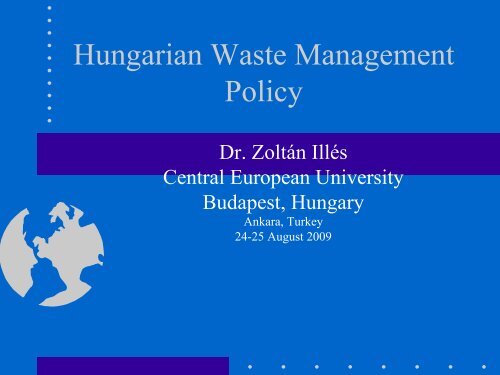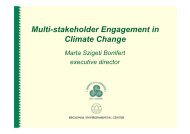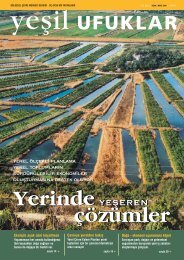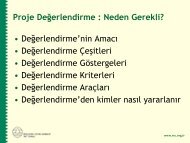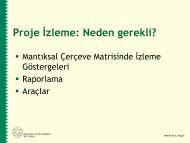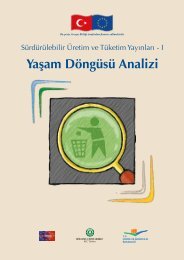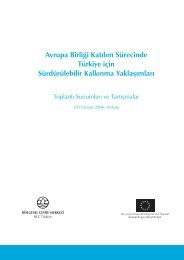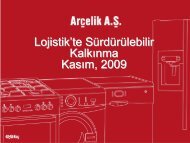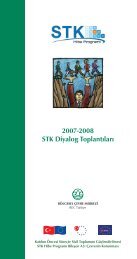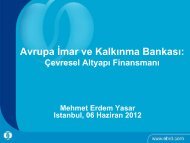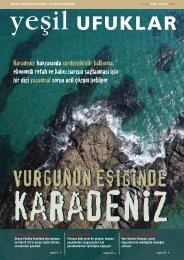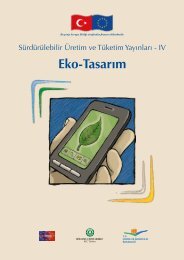Waste Management Issues In Hungary
Waste Management Issues In Hungary
Waste Management Issues In Hungary
Create successful ePaper yourself
Turn your PDF publications into a flip-book with our unique Google optimized e-Paper software.
Hungarian <strong>Waste</strong> <strong>Management</strong><br />
Policy<br />
Dr. Zoltán Illés<br />
Central European University<br />
Budapest, <strong>Hungary</strong><br />
Ankara, Turkey<br />
24-25 August 2009
Amount of waste in <strong>Hungary</strong>, 2004<br />
• Altogether 76 million tons<br />
• 60.1 mln t production waste, non-hazardous<br />
– 25 mln t agricultural<br />
– 10 mln t industrial<br />
– Construction, etc.<br />
• 7 mln t municipal liquid waste<br />
• 4.6 mln t municipal solid waste (MSW)<br />
• 4.3 mln t hazardous waste
Composition of MSW, 2004<br />
• 37.5 % organic<br />
• 14.5 % paper<br />
• 12.1 % plastic<br />
• 3.6 % glass<br />
• 3.8 % metal<br />
• 3.1 % textile<br />
• 1 % hazardous waste<br />
• 24.4 % other<br />
This is what can be recycled<br />
34 m%
Expected trends until 2010<br />
• Paper increases up to 25-30 m%<br />
• Plastic increases up to 15-17 m%<br />
• Organic decreases down to 25-30 m%<br />
Packaging<br />
• Packaging reaches 807,700 tonnes – 17.4 m% of the<br />
total MSW
• * estimated data<br />
<strong>Waste</strong> amount
<strong>Waste</strong> composition
6%<br />
Utilization of MSW in <strong>Hungary</strong> (m%)<br />
10% 2%<br />
82%<br />
Landfilled<br />
<strong>In</strong>cinerated<br />
Recycled<br />
Composted
Composition of packaging waste 2000 (m%)<br />
25%<br />
19%<br />
2%<br />
12%<br />
42%<br />
Metal<br />
Paper and cardboard<br />
Plastic<br />
Glass<br />
Other
<strong>Waste</strong> amount in some countries
The composition of the municipal solid waste,<br />
2004 (total amount 4,6 million tons/year)<br />
12.1%<br />
37.5%<br />
3.6%<br />
3.7%3.1%<br />
14.5%<br />
25.5%<br />
metal<br />
textile<br />
other<br />
paper<br />
organic<br />
plastic<br />
glass
Packaging emission by material type in 2005 (m%)<br />
28,60%<br />
7,39%<br />
16,10%<br />
3,40%<br />
26,30%<br />
0,01%<br />
18,20%<br />
Plastic<br />
Textile with natural base<br />
Glass<br />
Composite<br />
Wood<br />
Metal<br />
Paper and cardboard
<strong>Waste</strong> <strong>Management</strong> Act<br />
<strong>Waste</strong> <strong>Management</strong> Framework Act<br />
(came into force on 1st January, 2001<br />
including 35 decrees)<br />
• in every packaging material utilisation rate should<br />
reach 50%, recycling in the material itself should<br />
reach 15% at every type by 1st July, 2005<br />
• compostable content of the landfilled waste should<br />
reach 75% by 1st July, 2004; 50% by 2007; 35%<br />
by 2014 (<strong>Hungary</strong> has the right for more 2 years)
National <strong>Waste</strong> Managemet Plan<br />
National <strong>Waste</strong> <strong>Management</strong><br />
Plan (2003-2008)<br />
• selective waste collection should be established<br />
for at least 4 million people by 2005, and for 6<br />
million people by 2008<br />
• waste management plans should be elaborated<br />
(regional for the 7 regions, local - for<br />
municipalities, individual - for companies)
Regional <strong>Waste</strong> <strong>Management</strong> Plans<br />
• Data are different from the data of the<br />
National <strong>Waste</strong> <strong>Management</strong> Plan<br />
• The regions are not compliant with the<br />
ISPA and Cohesion Fund waste<br />
management regions data
Regions of <strong>Hungary</strong>
Name of the regions<br />
Translation of the regions is the following:<br />
• Nyugat-Dunántúl – West-Transdanubia<br />
• Közép-Dunántúl – Mid-Transdanubia<br />
• Észak-Magyarország – North-<strong>Hungary</strong><br />
• Észak-Alföld – North-Alföld<br />
• Dél-Alföld – South-Alföld<br />
• Dél-Dunántúl – South-Transdanubia<br />
• Közép-Magyarország – Mid-<strong>Hungary</strong>
Product fee<br />
• Act came into force in 1995<br />
• Due to the EU harmonisation the licence fee was<br />
introduced<br />
• several organisations were established for<br />
different types of waste (packaging, car battery,<br />
plastic, tyres, EEW etc.)<br />
• licence fee and product fee works paralell<br />
• From 1 January 2008 the Custom office controls<br />
the payment
Strategies in <strong>Hungary</strong> (related to waste)<br />
• <strong>Waste</strong> <strong>Management</strong> Act XLIII of 2000<br />
• National Environmental Programme II.<br />
2003-2008<br />
• National <strong>Waste</strong> <strong>Management</strong> Plan 2003-<br />
2008 (under revision)<br />
• New <strong>Hungary</strong> Development Plan<br />
• Solid waste development strategy<br />
• Solid waste supporting strategy
New <strong>Hungary</strong> Development Plan<br />
• Period: 2007-2013<br />
• Environment and Energy Operative<br />
Programme<br />
– Budget for environmental investments:<br />
4 916 289 813 euro
Solid waste development strategy<br />
• Települési Szilárdhulladék-gazdálkodási<br />
Fejlesztési Stratégia<br />
• Period: 2007- 2016<br />
• Assumptions:<br />
– Recovery of the MSW 40% by 2009-ig, 50%-by 2013<br />
(in material or thermal)<br />
– Ensure the selective waste collection facilities for 60%<br />
of the inhabitants by 2009, for 80% by 2013
The packaging waste generation and the amount which have to be<br />
recycled (1000 tons) 2002 2005 2012<br />
Glass Generated<br />
amount<br />
165 175 195-200<br />
Utilized 20 19 117-120<br />
From<br />
recycled<br />
this: 20 29 117-120<br />
Paper Generated<br />
amount<br />
370 400 450-460<br />
Utilized 216 296 368*<br />
From<br />
recycled<br />
this: 201 284 325-345<br />
Metal Generated<br />
amount<br />
95 90 125-130<br />
Utilized 35 54 79-85<br />
From<br />
recycled<br />
this: 35 54 79-85<br />
Plastic Generated<br />
amount<br />
160 170 200-210<br />
Utilized 29 43 63*<br />
From<br />
recycled<br />
this: 15 26 45-48<br />
Total Generated<br />
amount<br />
790 835 970-1000<br />
Utilized 300 422 585-600<br />
From<br />
recycled<br />
this: 271 393 535-550
The waste<br />
flow for<br />
2004<br />
(1000 tons)<br />
incineration<br />
155<br />
mixed waste collection<br />
4050<br />
3855<br />
MB waste<br />
40<br />
+ 39 + 10<br />
Landfilling<br />
3904 (85%)<br />
<strong>Waste</strong> amount<br />
4591<br />
loss 16<br />
Biological treatment<br />
120<br />
Home composting 80<br />
Separate waste collection<br />
460 (10%)<br />
Recycling from the<br />
selective waste collection<br />
340
The waste<br />
flow for<br />
2016<br />
(1000 tons)<br />
incineration<br />
420<br />
mixed waste collection<br />
3828<br />
1985<br />
+ 105 + 355<br />
MB waste<br />
1423<br />
<strong>Waste</strong> amount<br />
5688<br />
loss 570<br />
Landfilling<br />
2520 (44 %)<br />
Biological treatment<br />
720<br />
Home composting 220<br />
Separate waste collection<br />
1640 (29%)<br />
power plant 200<br />
incineration plant<br />
298<br />
Recycling from the<br />
selective waste collection<br />
920<br />
75
<strong>Waste</strong> management financing strategy<br />
• A TELEPÜLÉSI SZILÁRDHULLADÉKGAZDÁLKODÁS<br />
TÁMOGATÁSI STRATÉGIÁJA<br />
• Period: 2007-2015<br />
• Assumptions:<br />
– the treatment capacities will be built by the end of 2015<br />
– The Budapest incinerator will burn the same amount (420.000 tons/year)<br />
– Selective waste collection must be increased<br />
– Organic fraction should be composted (home composting)<br />
– <strong>Waste</strong> landfilling is decreased (by using mechanical biological treatment)
<strong>In</strong>cinerator study<br />
• Not a separate strategy, it was made for inhouse<br />
use for the Ministry by MKM-<br />
Consulting Kft.<br />
• Main points: the waste which can not be<br />
recycled will be treated by mechanical<br />
biological treatment. (-> landfilled or coincinerated<br />
- 12-17 MJ/kg)
Co-incineration opportunities<br />
• Cement factories<br />
– Beremend and Hejőcsaba, capacity 10-10 000 t/y<br />
• Power plants<br />
– Mátra power plant: capacity for co-incineration: 200 000 t/y<br />
– Vértes power plant : 20 000 t/y<br />
– Bakonyi power plant : co-incineration is planned<br />
– Pannon Power (Pécsi power plant): co-incineration is planned<br />
– AES Borsod power plant : co-incineration is not planned<br />
• Assumptions:<br />
– average waste amount: 2006 year: 357 kg/capita, 2015: 400 kg/capita, 2015: 439<br />
kg/capita<br />
– <strong>In</strong>cineration project can start only in an area where there is no available minimum<br />
5 year landfilling capacity
<strong>In</strong>cinerators in <strong>Hungary</strong>, 2006<br />
�1 piece of MSW incinerator (Rákospalota,<br />
Budapest), capacity: 420.000 tons/year<br />
�Additional 21 pieces of incinerators at 19<br />
locations (co-incineration, hazardous waste,<br />
medical waste, sludge)
Planned incinerators 1<br />
• Regional systems (2007-2014) – EU funding<br />
– <strong>In</strong>ota-Várpalota: Közép-Duna valley waste<br />
management system<br />
– Tatabánya: Duna-Vértes waste management system<br />
– Orosháza: Dél-Kelet wms<br />
Other waste management systems<br />
– Miskolc/ Hejőpapi/ Visonta/ Eger (Heves or Miskolc<br />
wms)<br />
– Sajókaza<br />
– Hajdúböszörmény surrounding<br />
– Szeged<br />
–Győr-Bácsa (Sopron)
Planned incinerators 2<br />
Private funding<br />
– Gyöngyös (Ecolnet-WTP) - 80.000 t/év<br />
– Szentgotthárd-Heiligenkreutzi (Begas AG)<br />
– (Dunakeszi) 50.000t/év<br />
Co-generation<br />
Nyergesújfalu - cementgyár -75.000 t/év<br />
– Visonta<br />
– Pécs Pannon Power v. Beremend<br />
– Polgár: gumihulladék
The planned collection regions of the planned<br />
incinerations
Landfill capacity in 2015
<strong>Waste</strong> treatment centres from ISPA and Cohesion projects
Main characteristics of the regions<br />
Name of the<br />
region<br />
Center of the<br />
Region<br />
Area<br />
(km²)<br />
Észak-<br />
Magyarország Miskolc 13 428 1 289 000<br />
Észak-Alföld Debrecen 17 749 1 554 000<br />
Dél-Alföld Szeged 18 339 1 367 000<br />
Population Counties<br />
Közép-<br />
Magyarország Budapest 6919 2 825 000 Pest<br />
Közép-Dunántúl Székesfehérvár 11 237 1 114 000<br />
Nyugat-Dunántúl Győr 11 209 1 004 000<br />
Dél-Dunántúl Pécs 14 169 989 000<br />
Borsod-Abaúj-<br />
Zemplén, Heves,<br />
Nógrád<br />
Hajdú-Bihar, Jász-<br />
Nagykun-Szolnok,<br />
Szabolcs-Szatmár-<br />
Bereg<br />
Bács-Kiskun,<br />
Békés, Csongrád<br />
Komárom-<br />
Esztergom, Fejér,<br />
Veszprém<br />
Győr-Moson-<br />
Sopron, Vas, Zala<br />
Baranya, Somogy,<br />
Tolna
ISPA and Cohesion Projects<br />
• There are 12 ISPA and 1 Cohesion Fund<br />
project approved<br />
• Process acceptance takes 4-5 years<br />
• Cover 60% of the population<br />
• Regional systems<br />
• Big landfill, big transport, big facilities<br />
• Prevention is highlighted only recently
Financing background in MSW<br />
• EU funds<br />
– ISPA Fund for more<br />
than 4 million<br />
euro/project<br />
– Cohesion Fund for<br />
more than 10 million<br />
euro/project (before<br />
2007)<br />
• Hungarian State<br />
• Municipalities<br />
80<br />
60<br />
40<br />
20<br />
0<br />
Average proportion in EU funded waste<br />
management projects<br />
Municipalities<br />
Hungarian State<br />
EU Funds
Changes in the Cohesion Fund<br />
• The Hungarian state can make decisions no<br />
need to send it to Brussels (under a financial<br />
limit)<br />
• No need to make large projects<br />
• EU: cut offs<br />
• More local initiatives are required<br />
• Recultivation is taken out from the current<br />
projects, and will be treated separately
North East Pest system<br />
• Problem: No place for the landfill<br />
• Solution: Kerepes undertake the place of the<br />
landfill
North Balaton system<br />
• Problem:Strong public opposition against<br />
the proposed place of the landfill in<br />
Szentgal<br />
• Solution: Kiralyszentistvan undertook the<br />
location
Mid Duna Valley system<br />
• This is the first incineration project in the<br />
EU<br />
• <strong>In</strong>cineration itself produces income, why<br />
finance?<br />
• Problem: the location of the inicnerator.<br />
Very strong public and political opposition<br />
in <strong>In</strong>ota<br />
• Solution: ?
Conclusion<br />
• As <strong>Hungary</strong> joined the EU the waste management system<br />
was also improved<br />
– Legislation: <strong>Waste</strong> management Act, regional waste management<br />
plans, operative programmes<br />
– Financing: EU financed app. 80% of the projects<br />
• Problems:<br />
– regional planning was weak, not taking into account other projects<br />
– no adequate consultations for the public -> strong opposition from<br />
the inhabitants<br />
– not always the best technology is taken to <strong>Hungary</strong> (incineration,<br />
MBT)<br />
• <strong>Waste</strong> management issue is highlighted, accepted<br />
• The Ministry and the NGOs are able to work together


